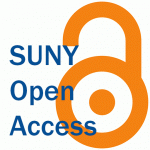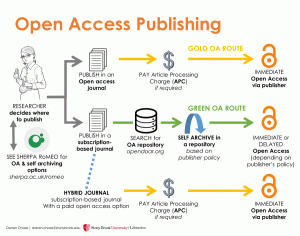
In terms of scholarly literature, open access applies to
digital, online, free of charge, and free of most copyright and licensing restrictions. What it means to academia and research is that the primary barrier to access, price, is removed from the equation, allowing free access to peer-reviewed, scholarly works, books, and just about any other electronic print material with the designation.
Open Access works fall under two main publishing categories:
Green Open Access
Free online access to peer-reviewed materials provided by the author (self archived, or published in an institutional repository).
Gold Open Access
Free online access provided by the journal itself, whether the journal is subscription-based, APC (article processing charge)-based, or subsidized. Open access journals can be searchable within a digital publisher’s collection. For example, EBSCO allows the user to limit searching to open access journals.

Open Access Publishing by Darren Chase
Open access to scholarly journal articles! Open access (OA) articles are:
- accessible at no cost on a journal website or in a repository committed to long-term archiving.
- available for all to read, download, print, copy, share, etc. (attribution always required, of course).
How do we achieve open access? There are two paths to open access:
Gold OA: Publish with publishers that automatically and immediately make the work available online to all at no cost. (Yes, some gold OA charge article publication fees. No, that doesn’t mean they’re vanity publishers. And no, those fees don’t necessarily come from authors’ pockets — they’re often paid by grant funds or institutional open access funds, and some publishers are willing to waive their fees.)
Green OA: Publish with publishers that allow authors to archive their articles in an online open access repository committed to long-term preservation — either a subject repository (e.g., PubMed Central, arXiv, SSRN) or a college/university institutional repository.
How can you find gold OA journals?
The
Directory of Open Access Journals (DOAJ) contains information about 9000+ gold OA journals.
How can you find green OA journals?
SHERPA/RoMEO provides easy-to-read summaries of journals’ copyright and self-archiving policies.
Looking for an OA Archive or Repository?
OpenDOAR is an authoritative directory of academic open access repositories.
You may have more rights than you realize!
According to SHERPA/RoMEO:
- 87% of scholarly journals allow immediate self-archiving of some version of the article.
- 60% of scholarly journals allow immediate self-archiving of the post-refereed version (including the 16% that allow immediate self-archiving of the final, published PDF).
- After the expiration of embargo periods (usually 6 to 24 months), 94% allow self-archiving of the post-refereed or PDF version of the article.
Can I negotiate my contract?
Sometimes. Your best shot is the
Scholar’s Copyright Addendum Engine.
Advice to authors: Know your rights to what you write!
-
- Research any journal you’re considering. (Quality? Peer reviewing process? Copyright policy?)
- If you have the right to self-archive, exercise that right.
- If you don’t have the right to self-archive, request it.
- Choose the best publishing venue for you and your career…
- …but also think about the system you’re contributing to and the one you want to contribute to.
Who and what benefits from open access?
Students, teachers, professors, researchers, libraries, universities, developing countries, health care providers, patients, journalists, policymakers, voters, the environment, consumer organizations, small businesses— everyone, everywhere, everything!
Even authors benefit! (Open access isn’t just altruistic!)
If an article is open access, it’s more likely to be read and more likely to be cited.
Page Content by Jill Cirasella, / CC BY-SA.
 In terms of scholarly literature, open access applies to digital, online, free of charge, and free of most copyright and licensing restrictions. What it means to academia and research is that the primary barrier to access, price, is removed from the equation, allowing free access to peer-reviewed, scholarly works, books, and just about any other electronic print material with the designation.
In terms of scholarly literature, open access applies to digital, online, free of charge, and free of most copyright and licensing restrictions. What it means to academia and research is that the primary barrier to access, price, is removed from the equation, allowing free access to peer-reviewed, scholarly works, books, and just about any other electronic print material with the designation.
